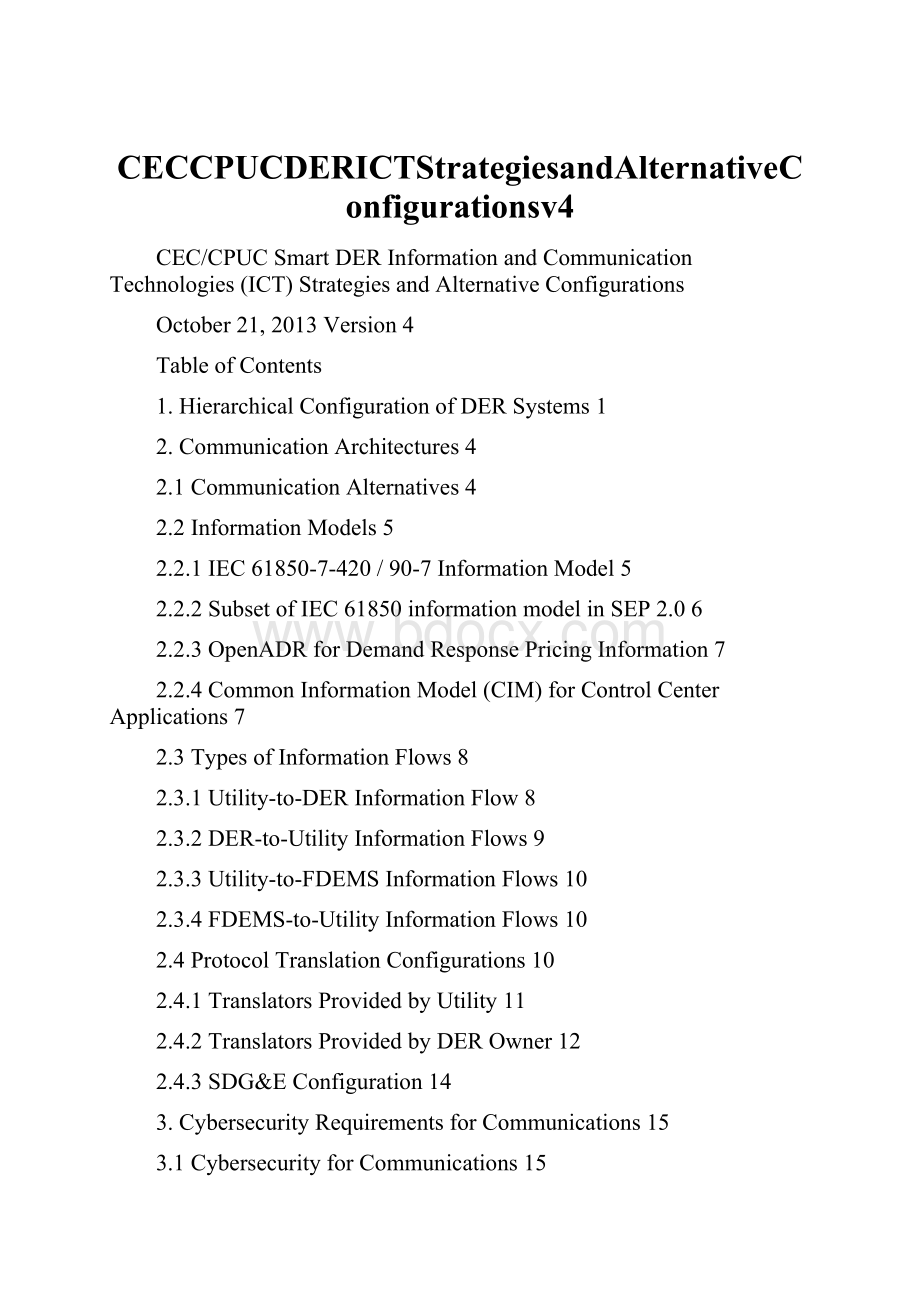CECCPUCDERICTStrategiesandAlternativeConfigurationsv4.docx
《CECCPUCDERICTStrategiesandAlternativeConfigurationsv4.docx》由会员分享,可在线阅读,更多相关《CECCPUCDERICTStrategiesandAlternativeConfigurationsv4.docx(21页珍藏版)》请在冰豆网上搜索。

CECCPUCDERICTStrategiesandAlternativeConfigurationsv4
CEC/CPUCSmartDERInformationandCommunicationTechnologies(ICT)StrategiesandAlternativeConfigurations
October21,2013Version4
TableofContents
1.HierarchicalConfigurationofDERSystems1
2.CommunicationArchitectures4
2.1CommunicationAlternatives4
2.2InformationModels5
2.2.1IEC61850-7-420/90-7InformationModel5
2.2.2SubsetofIEC61850informationmodelinSEP2.06
2.2.3OpenADRforDemandResponsePricingInformation7
2.2.4CommonInformationModel(CIM)forControlCenterApplications7
2.3TypesofInformationFlows8
2.3.1Utility-to-DERInformationFlow8
2.3.2DER-to-UtilityInformationFlows9
2.3.3Utility-to-FDEMSInformationFlows10
2.3.4FDEMS-to-UtilityInformationFlows10
2.4ProtocolTranslationConfigurations10
2.4.1TranslatorsProvidedbyUtility11
2.4.2TranslatorsProvidedbyDEROwner12
2.4.3SDG&EConfiguration14
3.CybersecurityRequirementsforCommunications15
3.1CybersecurityforCommunications15
3.2MajorCybersecurityRequirementsforCommunications15
3.3AuthenticationRequirements16
3.4DataIntegrityRequirements16
3.5ConfidentialityRequirements17
3.6AvailabilityRequirements17
1.HierarchicalConfigurationofDERSystems
DirectcontrolbyutilitiesisnotfeasibleatthistimeforthethousandsifnotmillionsofDERsystems“inthefield”,soahierarchicalapproachisnecessaryforutilitiestointeractwiththesewidelydispersedDERsystems.MostoftheseDERsystemswillbesmall,suchasroof-topPVsystems,butsomemaybegreaterthanafewmegawatts.
Atthelocallevel,bothlargeandsmallDERsystemsareexpectedtomanagetheirowngenerationandstorageactivitiesautonomously,basedonlocalconditions,pre-establishedsettings,andDERownerpreferences.However,thoseDERsystemsthatareactiveparticipantsingridoperationsmustbecoordinatedwithotherDERsystemsanddistributiongriddevices,andthuswouldrequirecommunicationscapabilities.Forsimplefacilities,suchasaresidentialhome,theDERcontrollerswouldprovidethesecommunicationscapabilities.LargerormoresophisticatedcustomersiteswouldincludeFacilitiesDERenergymanagementsystems(FDEMS)thatcouldmodifytheseautonomoussettingsandissuedirectcommands.ThedistributionutilitiescouldinteractwiththeseDERsystems,throughtheFDEMSifitisavailable,tooccasionallyupdatesettings,tobroadcastoperationalorpricingsignals,and/ortoissuecommands.
Inaddition,thedistributionutilitiesmustinteractwithregionaltransmissionorganizations(RTOs)and/orindependentsystemoperators(ISOs)forreliabilityandmarketpurposes.Insomeregions,retailenergyproviders(REPs)areresponsibleformanaginggroupsofDERsystems.
AlthoughingeneralDERsystemswillbepartofahierarchy,differentscenarioswillconsistofdifferenthierarchicallevelsandvariationsevenwithinthesamehierarchicallevel.Forinstance,smallresidentialPVsystemsmaynotincludeanyFDEMSoronlysimpleFDEMS,whilelargeindustrialandcommercialsitescouldincludemultipleFDEMSandevenmultiplelevelsofFDEMS.SomeDERsystemswillbemanagedbyRetailEnergyProvidersthroughdemandresponseprograms,whileothersmaybemanaged(notnecessarilydirectlycontrolled)byutilitiesthroughfinancialandoperationalcontractsortariffswithDERowners.Someofthelarger,morestrategicallyplacedDERsystems,suchasstoragesystemslocatedinsubstationsorlargenumbersofDERsystemsinapowerplant,maybecontrolleddirectlybytheutility.
Forthepurposeofunderstandingandspecifyingthecommunicationrequirements,thefirstfour(4)levelsofthe5-LevelhierarchicalDERsystemarchitectureisshowninFigure1anddescribedbrieflybelow.Inaddition,examplesoftheinformationmodels(e.g.IEC61850andCIM)andtheprotocolsfortransportingthedatadefinedbythemodels(e.g.DNP3,ModBus,andSEP2)areshownasyellowarrows.
Figure1:
First4LevelsoftheHierarchicalDERSystemArchitectureShowingCommunicationProtocols
1.Level1DERSystems(greenintheFigure)isthelowestlevelandincludestheactualcyber-physical(softwareplushardware)DERsystemsthemselves.TheseDERsystemswillbeinterconnectedtolocalgridsatElectricalConnectionPoints(ECPs)andtotheutilitygridthroughthePointofCommonCoupling(PCC).TheseDERsystemswillusuallybeoperatedautonomously.Inotherwords,theseDERsystemswillberunningbasedonlocalconditions,suchasphotovoltaicsystemsoperatingwhenthesunisshining,windturbinesoperatingwhenthewindisblowing,electricvehicleschargingwhenpluggedinbytheowner,anddieselgeneratorsoperatingwhenstartedupbythecustomer.Thisautonomousoperationiscontrolledbypre-setsoftwarevaluesthatareestablishedatdeployment,althoughthesevaluesmaybemodifiedlocallybyDERownerpreferenceswiththeconcurrenceoftheEPSoperator.
2.Level2FacilitiesDERManagement(blueintheFigure)isthenexthigherlevelinwhichafacilityDERmanagementsystem(FDEMS)managestheoperationoftheLevel1DERsystems.Forsimplefacilities,suchasaresidentialhome,theFDEMSmaybecombinedwiththeDERcontrollers,basicallyprovidingcommunicationscapabilitiestotheLevel1DERsystems.Ifaseparatesystem,theFDEMSmaybemanagingoneortwoDERsystemsinaresidentialhome(e.g.aPVsystemandanelectricvehicle).LargerFDEMSwillbemanagingmultipleDERsystemsincommercialandindustrialsites,suchasuniversitycampusesandshoppingmalls.UtilitiesmayalsouseaFDEMStohandleDERsystemslocatedatutilitysitessuchassubstationsorpowerplantsites.
3.Level3InformationandCommunicationsTechnology(ICT)Infrastructure(redintheFigure)providedtheinformationexchangesbeyondthelocalsitetoallowutilitiesandmarket-basedaggregatorsandretailenergyproviders(REP)torequestorevencommandDERsystems(typicallythroughaFDEMS)totakespecificactions,suchasturningonoroff,settingorlimitingoutput,providingancillaryservices(e.g.volt-varcontrol),andothergridmanagementfunctions.REP/aggregatorrequestswouldlikelybeprice-basedfocusedongreaterpowersystemefficiency,whileutilitycommandswouldalsoincludesafetyandreliabilitypurposes.Thecombinationofthislevelandlevel2mayhavevaryingscenarios,whilestillfundamentallyprovidingthesameservices,includingcybersecurity.
4.Level4DistributionUtilityOperationalAnalysis(yellow/brownintheFigure)appliestoutilityapplicationsthatareneededtodeterminewhatrequestsorcommandsshouldbeissuedtowhichDERsystems.UtilitiesmustmonitorthepowersystemandassessifefficiencyorreliabilityofthepowersystemcanbeimprovedbyhavingDERsystemsmodifytheiroperation.Thisutilityassessmentinvolvesmanyutilitycontrolcentersystems,including,butnotlimitedto,DistributionManagementSystems,GeographicalInformationSystems,LoadManagementSystems,OutageManagementSystems,DemandResponsesystems,aswellasDERdatabaseandmanagementsystems.Oncetheutilityhasdeterminedthatmodifiedrequestsorcommandsshouldbeissued,itwillsendtheseoutasperLevel3.
2.CommunicationArchitectures
2.1CommunicationAlternatives
FromtheDERlogicalarchitecturediagramsshownabove,itisclearthatanumberofdifferentprotocolsmaybeusedindifferentenvironmentsandfordifferentpurposes.Morethanonetypeofcommunicationmediamaybeusedacrossanetwork,differentprotocolsmaybeinvolved,anddifferenttypesofinformationexchangesmaybeneeded.Cybersecurityneedstobe“end-to-end”butdifferentmediaandprotocolsusedifferentcybersecuritymethods,includingdifferentciphersuites,differentkeymanagementapproaches,anddifferentnetworkmanagementmethods.
ThereforethefollowingissuesneedtobeaddressedinanyimplementationofDERsystemsthatwillinteractwithutilities(startingfromthehigherGWACStacklevelsdown):
∙WhatDERfunctionsrequirecommunicationsbetweenutilitiesandDERsystems?
–SeetheCPUCRule21RecommendationsdocumentforPhases1-3.
∙What(abstract)informationmodelsmightbeusedformanagingtheseDERfunctions?
–IEC61850-7-420and90-7informationmodelforDERmonitoringandcontrol
–OpenADRinformationmodelfordemandresponsepricinginformation
–CommonInformationModel(CIM)forcontrolcenterapplications
∙WhattypesofdataneedtobeexchangedbetweenutilitiesandDERsystems,includingFacilityDERenergymanagementsystems(FDEMS),basedontheinformationmodels?
–Utility-to-DER:
–DER-to-Utility:
–Utility-to-FDEMS:
–FDEMS-to-Utility:
∙What(application-layer)communicationprotocolscouldbeused?
–UtilitiesuseDNP3forSCADA-typedataexchanges
–UtilitiesmayuseSEP2.0forsomeinteractionswithcustomerpremises
–UtilitiesmayuseOpenADRXML-basedprotocolformarketinteractions
–DERsystemsuseModBus
–NewIECefforttomap61850toXMLovertheXMPPprotocol(anIETFprotocolforinstantmessaging)
∙Whatmappingsareavailablebetweentheabstractinformationmodelsandtheprotocols?
–EPRI-sponsoredmappingbetweenIEC61850andDNP3
–SunSpecmappingbetweenIEC61850andModBus
–SunSpecmappingbetweenIEC61850andSEP2.0
–ASHRAESP201isworkingonsuchamodel
–IECTC57WG17isdevelopinganXML-basedmappingof61850
∙Whattranslationsareneededbetweenprotocols?
–BetweenDNP3andModBus
–BetweenSEP2.0andModBus
–BetweenSEP2.0andDNP3(?
)
–BetweenModBusandXML(?
)
∙What(transport-layer)communicationprotocolswillbeused?
–TCP/IPforallprotocolsexceptModBus
∙Whatcommunicationmediawillbeused?
–